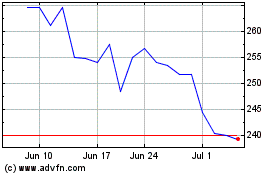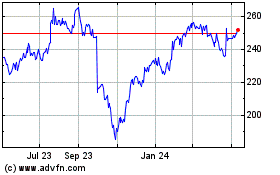(FROM THE WALL STREET JOURNAL 9/2/15)
By Ted Mann
When Honeywell International Inc. was thinking of buying a maker
of hand and foot protection in 2008, one of its executives toured a
Charleston, S.C., factory owned by the target and was shocked.
Bales of raw Malaysian rubber and industrial solvents and dyes
were scattered around the ramshackle plant. The huge vats where
rubber gloves for utility workers were repeatedly dipped until
thick enough to resist 40,000 volts of electricity were badly aged.
The executive called the office and delivered a frank report: This
doesn't look anything like what Honeywell does.
Chief Executive Dave Cote gave the green light to buy the
company, for $1.2 billion, anyway. Honeywell poured in investment,
cutting the lead time for making one of the painstakingly
hand-dipped rubber gloves from a year to 30 days while reducing
waste.
Now Honeywell, best known for building sophisticated products
like 3-D weather radar and aircraft guidance systems, is also in
the business of manufacturing gloves and boots.
Activist investors in companies have made "conglomerate" a dirty
word. Across corporate America, the pressure is on to split up and
concentrate on the most promising lines of business. Yet even as
rival General Electric Co. dismantles its sprawling financial
operations and smaller companies like Danaher Corp. and Johnson
Controls Inc. break up, a select group that includes Honeywell has
bucked the trend toward a sharper focus and drawn cheers from
investors for diversified lineups.
Honeywell has done 84 acquisitions in the 13 years under Mr.
Cote, adding about $12 billion in annual sales and ending up with a
stable of about 65 different brands. The company in late July
announced a $5.1 billion deal for Elster Group, a maker of gas,
water and electricity meters -- the largest acquisition of Mr.
Cote's tenure.
The result is an array of loosely related offerings, from
satellite-based Wi-Fi systems for corporate jets to antistatic
"finger cots," small, rubber finger sheaths used in the assembly of
sensitive electronics and computer chips. The company still makes
the Honeywell thermostats that have dotted the walls of American
homes for generations and which gave the corporation its name. Now,
the same entity boasts "optimal earmuff attenuation" in its hearing
protection gear for industrial workers, while also producing a
range of chemical agents and industrial components for refining oil
and natural gas.
So far, investors approve of the corporate sprawl. The company's
shares Tuesday closed at $95.96, up from $32.65 on the day Mr. Cote
took over in 2002. That 194% gain is more than twice the increase
booked by the S&P 500 over the same period.
The question is whether Honeywell can keep the act going. Small,
disciplined deals for boot makers are no longer enough to make a
meaningful difference in growth at a company with $40 billion in
revenue last year. Investors now want Honeywell to make bigger
deals while keeping risk in check. They worry about the
availability of suitable targets.
Conversely, analysts from Deutsche Bank warned in April that
investors' patience for Honeywell's diverse business lines could
grow short now that peers like GE, under shareholder pressure, are
making dramatic adjustments to their portfolios.
"Companies aren't born with a right to be a conglomerate," said
Steve Winoker, an analyst at Bernstein Research, who briefly worked
for Honeywell as a vice president of global strategy from 2006 to
2007. "That's a right only earned over time. And until you earn it,
the presumption should be you can't do it."
Run well, a conglomerate can make acquired businesses more
valuable by improving management, introducing them to new customers
and expanding overseas. The diversity then reduces the parent
company's exposure to any one risk or market.
But peers have long faced pressure to reduce complexity and
focus on fundamentals. GE, for example, is attempting to sell its
slow-growing appliance business, and is shedding its profitable
financial-services arm.
United Technologies Corp., which has a broad range of businesses
from jet engines to air handlers to food-service equipment,
announced in July it would sell its Sikorsky helicopter unit to
Lockheed Martin Corp. for $9 billion.
Danaher, which has acquired more than 400 companies since 1984,
especially in science and medical technology, announced plans in
May to acquire filtration and fluid management company Pall Inc.
and then split the conglomerate into two separate companies, one
focused on life-science and diagnostics equipment and the other on
measuring instruments and automation.
"Both companies will be able to accelerate revenue and earnings
growth as smaller, more focused, independent businesses," Danaher
Chief Executive Thomas Joyce told investors on a conference call
when the decision was announced.
Johnson Controls, another multi-industry company, recently
announced it would jettison its business making automotive seats
and interiors, to focus on two remaining units that make building
control panels and sensors and battery systems. The company told
investors that the automotive unit would better be able to invest
in new product lines if it was disconnected from the other
businesses.
Honeywell, however, said it remains comfortable with its
breadth. Mr. Cote bristled in an interview that industrial
companies like his are more likely to be questioned about the
diversity of their business lines than firms in other sectors.
Google, for instance, has expanded from Internet searches into
contact lenses, self-driving cars and even robots but seems to get
a pass from investors.
But Honeywell is different from both Google, which recently
announced it would separate its core Internet business from more
experimental ventures, and traditional holding companies such as
Berkshire Hathaway.
Google's new structure is intended in part to prevent its
diverse interests from overwhelming the company's main engine of
profit. While at Berkshire, its various companies operate in
relative autonomy.
Honeywell maintains the structure of a diversified conglomerate,
where three strategic business units rise and fall in their
respective markets, and can help boost one another in hard times.
The three sectors -- aerospace, automation and control systems, and
performance materials -- rely on the headquarters for traditional
functions, like corporate finance and research and development. The
company says it also uses shared distribution and sales networks to
boost sales and generate efficiency across its different product
lines.
Mr. Cote said the real risk isn't in having a diversified
business, but in getting caught up in "fad-surfing" -- trying to
find new markets or business lines that don't fit a company's
strengths or come at too high a cost.
"I've always thought that was a great way to lose a lot of
money," Mr. Cote said.
A decade and a half ago, Honeywell botched a merger with
AlliedSignal, leaving rifts in the management of the company that
hampered cooperation and hurt morale. It left a mess that employees
nicknamed "Honey Hell." The wounded company was then almost taken
over by GE, but when European regulators shot down the acquisition,
it was left with bleak prospects.
Upon arrival at Honeywell, Mr. Cote turned his attention to
integrating factions within the company and cutting waste. He
learned how to do that in the finance department at GE, where he
was a point person on the integration of RCA after CEO Jack Welch
jumped into the broadcasting business in the early 1980s.
As Honeywell's new CEO -- previous CEO Lawrence A. Bossidy had
retired -- Mr. Cote instituted an aggressive but straightforward
acquisition strategy. The company would look for midsize deals in
business lines close to the ones in which it already operated,
ideally in fragmented, tightly regulated, even mundane markets
where Honeywell could instantly become a heavyweight. The
philosophy, Mr. Cote has said, is to have a great position in good
markets.
At the end of the last decade, that logic led to gloves and
boots. The New Jersey-based company expanded from its business
selling fire alarms and security systems into worker safety by
buying a company that had a technology for sniffing out gas
leaks.
From there, Honeywell leapt into personal safety, beginning with
the 2008 deal for Norcross Safety Products LLC, which owned
Salisbury, the dilapidated maker of safety gloves for utility
workers. Norcross's properties also included various lines of heavy
duty rubber boots for firefighters, utility workers and fishermen.
One line popular with fishermen, Xtratuf, once made a high-heeled
pair for Miss Alaska. Another line, Muck Boots, is popular with
hunters and outdoorsmen.
"We own Muck boots?" Mr. Cote said on a postdeal conference call
with his deals team, after learning the brand was one of those
Honeywell planned to dump. He ordered the group to keep Muck and
figure out a way to make it grow, he said.
Fixing Norcross didn't come without headaches. One of the
company's two boot plants in Rock Island, Ill., lacked basic safety
equipment -- a person familiar with the matter called it a
disaster.
Honeywell closed the Illinois facility and spent millions
building a new factory in China, but poor workmanship there caused
the famously watertight boots to leak. Xtratuf devotee Mark Begich,
then a U.S. senator from Alaska, sent Mr. Cote an open letter of
protest about the move to China and the decline in quality. (The
other Rock Island factory, which makes Servus boots, remains in
operation.)
Honeywell blamed the problems on poor worker training, which it
said it amended. It also said it increased inspections and expanded
testing. The aerospace and thermostat conglomerate now commands
rack space in the footwear aisle at sporting-goods retailer
Cabela's -- despite some persistent negative reviews online -- and
has branched out into camp shoes and gardening clogs.
(MORE TO FOLLOW) Dow Jones Newswires
September 01, 2015 19:59 ET (23:59 GMT)
Copyright (c) 2015 Dow Jones & Company, Inc.
Danaher (NYSE:DHR)
Historical Stock Chart
From Mar 2024 to Apr 2024

Danaher (NYSE:DHR)
Historical Stock Chart
From Apr 2023 to Apr 2024
